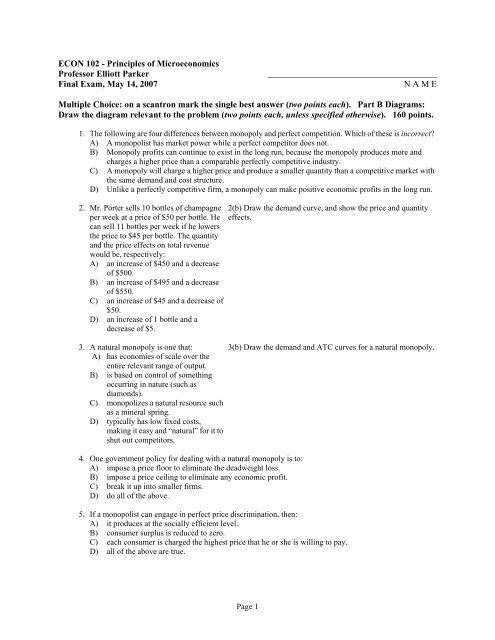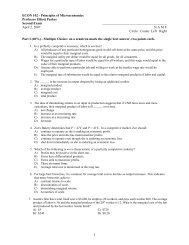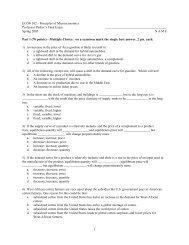ECON 102 - Principles of Microeconomics Professor Elliott Parker ...
ECON 102 - Principles of Microeconomics Professor Elliott Parker ...
ECON 102 - Principles of Microeconomics Professor Elliott Parker ...
You also want an ePaper? Increase the reach of your titles
YUMPU automatically turns print PDFs into web optimized ePapers that Google loves.
<strong>ECON</strong> <strong>102</strong> - <strong>Principles</strong> <strong>of</strong> <strong>Microeconomics</strong>Pr<strong>of</strong>essor <strong>Elliott</strong> <strong>Parker</strong>Final Exam, May 14, 2007______________________________________N A M EMultiple Choice: on a scantron mark the single best answer (two points each). Part B Diagrams:Draw the diagram relevant to the problem (two points each, unless specified otherwise). 160 points.1. The following are four differences between monopoly and perfect competition. Which <strong>of</strong> these is incorrect?A) A monopolist has market power while a perfect competitor does not.B) Monopoly pr<strong>of</strong>its can continue to exist in the long run, because the monopoly produces more andcharges a higher price than a comparable perfectly competitive industry.C) A monopoly will charge a higher price and produce a smaller quantity than a competitive market withthe same demand and cost structure.D) Unlike a perfectly competitive firm, a monopoly can make positive economic pr<strong>of</strong>its in the long run.2. Mr. Porter sells 10 bottles <strong>of</strong> champagneper week at a price <strong>of</strong> $50 per bottle. Hecan sell 11 bottles per week if he lowersthe price to $45 per bottle. The quantityand the price effects on total revenuewould be, respectively:A) an increase <strong>of</strong> $450 and a decrease<strong>of</strong> $500.B) an increase <strong>of</strong> $495 and a decrease<strong>of</strong> $550.C) an increase <strong>of</strong> $45 and a decrease <strong>of</strong>$50.D) an increase <strong>of</strong> 1 bottle and adecrease <strong>of</strong> $5.3. A natural monopoly is one that:A) has economies <strong>of</strong> scale over theentire relevant range <strong>of</strong> output.B) is based on control <strong>of</strong> somethingoccurring in nature (such asdiamonds).C) monopolizes a natural resource suchas a mineral spring.D) typically has low fixed costs,making it easy and “natural” for it toshut out competitors.4. One government policy for dealing with a natural monopoly is to:A) impose a price floor to eliminate the deadweight loss.B) impose a price ceiling to eliminate any economic pr<strong>of</strong>it.C) break it up into smaller firms.D) do all <strong>of</strong> the above.2(b) Draw the demand curve, and show the price and quantityeffects.3(b) Draw the demand and ATC curves for a natural monopoly.5. If a monopolist can engage in perfect price discrimination, then:A) it produces at the socially efficient level.B) consumer surplus is reduced to zero.C) each consumer is charged the highest price that he or she is willing to pay.D) all <strong>of</strong> the above are true.Page 1
6. In a perfectly competitive industry, a binding price ceiling will _________, but in a monopolistic industry,a price ceiling will _____________ as long as it remains above marginal cost.A) reduce quantity-supplied and the deadweight loss; increase quantity and the deadweight loss.B) increase quantity-supplied and create a deadweight loss; increase quantity and reduce deadweight loss.C) reduce quantity-supplied and create a deadweight loss; reduce quantity and the deadweight loss.D) reduce quantity-supplied and create a deadweight loss; increase quantity and reduce deadweight loss.7. Suppose a monopoly can separate its customers into two groups. If the monopoly practices pricediscrimination, it will charge the lower price to the group with:A) the higher price elasticity <strong>of</strong> demand.B) the lower price elasticity <strong>of</strong> demand.C) the fewer close substitutes.D) The answer cannot be determined with the information given.7(b). Assuming marginal cost is constant, draw graphs showing price discrimination for the two groups, and thepr<strong>of</strong>it-maximizing price and quantity for each. (4 points)8. In the classic prisoners' dilemma withtwo accomplices in crime, the NashEquilibrium is for:A) both individuals to not confess.B) both individuals to confess.C) one to confess and the other notconfess.D) This game does not have a NashEquilibrium.9. If there are two gas stations in the town <strong>of</strong>Gerlach, then the gasoline industry inGerlach is probably best characterized as:A) monopolistic competitive.B) monopolistic.C) oligopolistic.D) Perfect competitive.8(b). Create a pay<strong>of</strong>f matrix for prisoners X and Y, using onlypay<strong>of</strong>fs <strong>of</strong> 0, -1, -2, and -3. (4 points)10. If Bruno's Gas and Frank's Fuel are the only two firms providing gasoline in Gerlach, and they decide t<strong>of</strong>orm a cartel to raise the price <strong>of</strong> gasoline. The total industry pr<strong>of</strong>its are highest when ______, and Bruno'spr<strong>of</strong>its are highest when ______.A) Neither firm cheats on the agreement; neither firm cheats on the agreementB) Neither firm cheats on the agreement; Bruno cheats on the agreement and Frank does not cheatC) both firms cheat on the agreement; Bruno cheats on the agreement and Frank does not cheatD) both firms cheat on the agreement; both firms cheat on the agreement11. Bruno summarizes his pricing strategy as: "I'll do to Frank what Frank did to me last time." This is anexample <strong>of</strong>:A) a tit-for-tat strategy. C) an irrational strategy.B) a dominant strategy. D) a Cournot strategy.Page 2
12. Toby operates a small deli downtown. The deli industry is monopolistically competitive. If some delisleave the industry, Toby's _____ curve will shift _____.A) marginal cost; leftB) marginal cost; rightC) demand; leftD) demand; right13. Suppose a monopolisticallycompetitive firm is in long-runequilibrium. Then:A) price equals marginalrevenue.B) price equals marginal cost.C) price is greater than averagetotal cost.D) all <strong>of</strong> the above are true.E) none <strong>of</strong> the above are true.13(b) Show the Demand, MR, MC, and ATC curves for this firm.(4 points)14. The restaurant industry is characterizedby excess capacity. This means:A) restaurants are producing morethan their pr<strong>of</strong>it-maximizing level.B) the pr<strong>of</strong>it-maximizing level is less than the level that minimizes average total costs.C) the restaurants are producing less than their pr<strong>of</strong>it-maximizing level.D) the quantity <strong>of</strong> restaurant meals supplied exceeds the quantity <strong>of</strong> restaurant meals demanded.15. The broccoli market is perfectly competitive. This means that the price <strong>of</strong> broccoli is _____ than the pricewould be if the market was monopolistically competitive, and broccoli output is _____ than if it wasmonopolistically competitive.A) lower; greater C) greater; lessB) lower; less D) greater; greater16. Monopolistic competitors <strong>of</strong>ten hire a celebrity spokesperson to advertise their product. One explanationfor why such advertising works is that:A) celebrities are better informed about the relative merits <strong>of</strong> different products than the rest <strong>of</strong> us.B) consumers assume that the celebrity has researched the product and that the claims being made on hisor her behalf are true.C) the fact that a firm is willing to pay the large fees associated with celebrity advertising signalsconsumers that it is a major company, and that it is therefore likely to have a reliable product.D) None <strong>of</strong> the above17. Lower wages in China reflect ______ labor productivity in China. If the United States has a comparativeadvantage in high-tech industries, then if these industries moved to China, their average total productioncosts would be ______ in China than in the United States.A) lower; higher C) higher; higherB) lower; lower D) higher; lower18. Suppose that wages were so much lower in China than in the United States, that China could produceeverything more cheaply. Thus, unless China’s government intervened in China’s foreign exchangemarket, we would expect:A) China’s currency would appreciate, but the U.S. price <strong>of</strong> Chinese goods would be unchanged.B) China’s currency would depreciate, and Chinese goods would become cheaper.C) China’s currency would appreciate, and Chinese goods would become cheaper in the U.S.D) China’s currency would appreciate, and Chinese goods would become more expensive in the U.S.Page 3
19. In a single growing season, the country <strong>of</strong> Pastoral can raise 100 tons <strong>of</strong> beef or produce 900 bushels <strong>of</strong>wheat. In the same growing season, the country <strong>of</strong> Bucolic can raise 50 tons <strong>of</strong> beef or produce 800 bushels<strong>of</strong> wheat. We then know that:A) Pastoral has the comparative advantage in raising beef.B) Pastoral has the comparative advantage in growing wheat.C) Bucolic has the comparative advantage in raising beef.D) Bucolic has the absolute advantage in raising beef.19(b). Draw PPFs for the countries <strong>of</strong> Pastoral and Bucolic, with wheat on the horizontal axes. Find the slopes,and show the production points where each specializes according to its comparative advantage. (4 points)20. If the United States placed larger tariffs on all textiles, then:A) producer surplus would increase.B) consumer surplus would decrease.C) Total surplus would decrease.D) all <strong>of</strong> the above are true.21. Suppose that an individual is risk-averse. If thisindividual's utility function is depicted in a graph,with income measured on the horizontal axis and“utils” on the vertical axis, the graph would be:A) an upward-sloping straight line through theorigin.B) an upward-sloping curve with a steadilydecreasing slope (i.e., a curve that is concavefrom below).C) an upward-sloping curve with a steadilyincreasing slope (i.e., a curve that is convexfrom below).D) an upward-sloping straight line with a positivevertical intercept.21(b) Graph this utility function.22. Risk-averse individuals are willing to pay a premium that is ______ their expected claims.A) less than C) greater thanB) equal to D) the inverse <strong>of</strong>23. An individual is considering buying shares in two different companies, A and B. For every $1,000 heinvests in A, there is a 40% probability that his investment will be worth only $800 and a 60% probabilitythat it will be worth $1,200. The corresponding risk for investment in B is identical but independent. Theprobability that he will make a loss (i.e., that his investment will be worth less than $1,000) is ______ if heinvests $2,000 in either A or B, and is ______ if he invests $1000 each in A and in B.A) 40%; 40% C) 80%; 20%B) 40%; 16% D) 40%; 80%Page 4
24. Louis has invested $1,000 in the stock market. At the end <strong>of</strong> one year, there is a 30% chance that his stockwill be worth only $800, and a 70% chance that it will be worth $1,200. The expected value <strong>of</strong> his stock atthe end <strong>of</strong> one year is:A) $1,000. C) $1,200.B) $1,080. D) $1,160.25. Moral hazard:A) occurs when incentives are distorted, because an individual knows more about his or her own actionsthan other people do.B) is a term used to describe the bonuses paid for particularly hazardous jobs (such as fire-fighting).C) is a term used synonymously with “value judgment.”D) refers to the questionable morality <strong>of</strong> price gouging in hazardous times (e.g., in the presence <strong>of</strong>famines, floods, etc.).26. Individuals differ in risk-aversion for which <strong>of</strong> the following reasons?A) adverse selectionB) moral hazardC) differences in income or wealthD) all <strong>of</strong> the above27. Which <strong>of</strong> the following is an example <strong>of</strong> anactivity generating a negative externality?A) Your next-door neighbor mows the lawn at6 am.B) You buy a new car, then discover it needs anew transmission.C) The only two c<strong>of</strong>fee shops in townconspire to raise prices.D) After Jane bought health insurance, shebegan racing motorcycles on theweekends.27(b) Diagram the private and social marginal costs andthe marginal benefit for this externality.28. Given that there is general agreement that pollution isundesirable and social welfare is increased by reducingpollution, the optimal level <strong>of</strong> pollution in a society is:A) zero.B) that level which reduces marginal social costs <strong>of</strong> pollution to zero.C) the level <strong>of</strong> pollution at which the marginal social cost <strong>of</strong> pollution is equal to the marginal socialbenefit <strong>of</strong> pollution.D) None <strong>of</strong> the above.29. Suppose government <strong>of</strong>ficials have set anemissions tax to reduce pollution. Assume theoptimal tax would be $1,500, but government<strong>of</strong>ficials have set the tax equal to $500. Then,we can conclude that at equilibrium:A) There will be too much pollution.B) the marginal social cost <strong>of</strong> pollution will begreater than $500.C) the marginal social benefit <strong>of</strong> pollution willbe $500.D) all <strong>of</strong> the above29(b) Show the effect <strong>of</strong> the tax in this case.Page 5
30. In the absence <strong>of</strong> government action, polluters will pollute up to the point at which the marginal socialbenefit <strong>of</strong> pollution is:A) equal to the marginal social cost <strong>of</strong> pollution.B) zero.C) maximized.D) greater than the marginal social cost <strong>of</strong> pollution.31. There are two plants (A and B) in an industry. To reduce pollution, the government has imposedenvironmental standards forcing each plant to cut emissions by 60%. At the emissions standard, themarginal social benefit <strong>of</strong> pollution for Plant A is $500 and the marginal social benefit <strong>of</strong> pollution for PlantB is $125. The same level <strong>of</strong> pollution can be achieved at a lower cost by:A) forcing Plant A to reduce emissions and allowing Plant B to increase emissions.B) allowing both plants to pollute more.C) forcing both plants to reduce emissions.D) allowing Plant A to pollute more and Plant B to pollute less.32. Which <strong>of</strong> the following statements about environmental standards and emissions taxes is correct?A) An emissions tax is a more efficient way to reduce pollution than an environmental standard, becausean emissions tax leads to an equalization <strong>of</strong> the marginal benefit <strong>of</strong> pollution from all sources.B) An environmental standard is a more efficient way to reduce pollution than an emissions tax, becausean environmental standard can be structured to lead to an equalization <strong>of</strong> the reduction in pollutionfrom all sources.C) If an emissions tax and environmental standards lead to the same total reduction in pollution, then theywill also lead to the same reduction in pollution by individual polluters.D) It is easy to set emissions taxes at the “correct” level, since the relationship between emissions taxesand the reduction in emissions that they will induce has been extensively studied and is well-known.33. When an activity like education generates a positive externality, the:A) marginal cost <strong>of</strong> production is below the market demand curve.B) market demand curve is above the marginal social benefit curve.C) market demand curve is below the marginal social benefit curve.D) market will produce more than the efficient level <strong>of</strong> output.34. If left totally to the free market, the amount <strong>of</strong> police protection provided in a city would be _____ than it isnow, and free-riders would pay _____ for police protection.A) less; a higher price C) more; moreB) less; nothing D) more; nothing35. Common resources tend to be overused because:A) individuals tend to ignore the cost their use <strong>of</strong> the resource has on others.B) the individual marginal cost is greater than the marginal social cost.C) common resources are nonrivalrous and nonexcludable.D) property rights are well defined and enforceable.E) the marginal cost <strong>of</strong> allowing one more unit <strong>of</strong> consumption is zero.36. A good is most likely to be artificially scarce if:A) it is nonexcludable and nonrivalrous.B) the seller is a monopolist.C) it is nonexcludable but rivalrous.D) it is excludable but nonrivalrous.37. The problem created by artificially scarce goods is similar to that <strong>of</strong>:A) externalities.B) an oligopoly.C) a natural monopoly.D) Price discrimination.Page 6
38. A tax system achieves “tax efficiency” when:A) the people who bear the burden <strong>of</strong> taxes are those who use the service.B) it minimizes the costs to the economy <strong>of</strong> tax collection.C) Those with higher incomes pay a higher tax rate.D) Those with higher incomes pay more taxes, but at a lower tax rate.D) Both b and c39. A lump-sum tax, such as the fee for a driver's license, does not take into consideration:A) efficiency.B) the benefits principle.C) the ability-to-pay principle.D) the tax base.40. In 2004, the Social Security tax was only levied on incomes up to $87,900. Which <strong>of</strong> the followingstatements about this tax is correct?A) A worker with an annual income <strong>of</strong> $200,000 and one with an annual income <strong>of</strong> $100,000 would paythe same dollar amount <strong>of</strong> payroll tax.B) A worker with an annual income <strong>of</strong> $50,000 and one with an annual income <strong>of</strong> $100,000 would paythe same dollar amount <strong>of</strong> payroll tax.C) The top 20% <strong>of</strong> income earners earned over 50% <strong>of</strong> total U.S. incomes in 2001, and they paidapproximately 60% <strong>of</strong> the total payroll taxes collected that year.D) The percentage <strong>of</strong> income paid in payroll taxes would be the same for a worker with an annual income<strong>of</strong> $50,000 and a worker with an annual income <strong>of</strong> $100,000.41. An efficient way to finance the provision <strong>of</strong> city services (such as street cleaning) would be to charge all cityresidents a lump-sum tax. Such a tax would be:A) progressive.B) regressive.C) proportional.D) This question can't be answered without knowing the amount <strong>of</strong> the tax.42. U.S. federal taxes income are generally _______ and state and local taxes are generally _______.A) progressive; progressiveB) regressive; progressiveC) progressive; regressiveD) regressive; regressive43. From 1960 to 2003, federal spending as a percentage <strong>of</strong> GDP:A) doubled.B) tripled.C) decreased.D) remained about the same.44. Compared to the seven largest economies in the world, U.S. government spending as a percentage <strong>of</strong> GDPin 2002 was:A) the largest <strong>of</strong> the seven countries.B) the smallest <strong>of</strong> the seven countries.C) the second largest <strong>of</strong> the seven countries.D) the third smallest <strong>of</strong> the seven countries.45. The characteristic cost structure <strong>of</strong> information goods involves _______ and _______.A) High fixed cost; low marginal costB) Low fixed cost; high average total costC) High fixed cost; low average total costD) Low fixed cost; high marginal costPage 7
46. The economic argument for patent protection <strong>of</strong> life-saving drugs is that:A) government intervention may be necessary to enforce superior standards.B) monopolization should always and everywhere be prevented.C) a temporary monopoly provides an incentive that encourages research and innovation.D) Most new inventions are actually public goods.47. Network externalities exist when the value to the consumer <strong>of</strong> a good rises as the number <strong>of</strong> people who usethe good:A) increases.B) decreases.C) remains constant.D) None <strong>of</strong> the above.48. When VCRs were first produced, two different systems were available: VHS and Betamax. VHS eventuallydominated and Betamax disappeared. This was because:A) VHS was unambiguously the better system.B) consumers chose VHS because most <strong>of</strong> the videocassettes available for rental were VHS.C) consumers chose VHS because the majority <strong>of</strong> other consumers were choosing VHS.D) Both b and c.49. The United States lags behind Europe in cell-phone technology because:A) Europe subsidized cell-phone research and the United States did not.B) Europe adopted a common standard for digital-cellular phones and the United States did not.C) the United States allowed no imports <strong>of</strong> cell phones.D) the United States heavily taxes producers <strong>of</strong> cell phones.50. Which <strong>of</strong> the following will not cause a change in demand?A) Change in income.B) Change in the number <strong>of</strong> buyers.C) Change in the good's own price.D) Change in the price <strong>of</strong> related goods, such as complements and substitutes.E) Change in expectations <strong>of</strong> future prices.For 51-52, suppose the government imposes a tax on a specific type <strong>of</strong> market transaction, such as the sale <strong>of</strong> anautomobile.51. Buyers will pay relatively less <strong>of</strong> the tax if: 51(b) Show the effects <strong>of</strong> this tax on the market.A) a sales tax is charged to the seller,instead <strong>of</strong> to the buyer.B) both supply and demand are more elastic.C) both supply and demand are less elastic.D) demand is relatively more elastic than supply.E) supply is relatively more elastic than demand.52. The deadweight loss from the tax will:A) rise proportionately with the tax.B) rise more than proportionately with the tax.C) rise with the tax, but at a decreasing rate.D) rise to a maximum, and then fall as the tax keeps rising.53. If government wants to maximize the revenue from a tax, it should levy taxes on products where demand is:A) unit elastic C) elasticB) downward-sloping D) inelasticPage 8
54. If two goods are substitutes and the price <strong>of</strong> one 54(b) Show this change in demand.good decreases, then the demand for the other willA) decrease.B) increase.C) not be affected.D) not change, but quantity-demanded will fall.E) not change, but quantity-demanded will rise.For questions 55 and 56, consider the market for legalpharmaceutical drugs in a large city. Assume that theseprescribed drugs are normal goods and the price elasticity<strong>of</strong> demand for drugs is 1.20.55. Suppose the wage for pharmacists’ labor goes up. The equilibrium price is expected to _______, theequilibrium quantity is expected to ______, and total consumer expenditures on drugs areexpected to ________.A) increase; decrease; decrease C) decrease; decrease; decreaseB) increase; decrease; increase D) decrease; increase; increase56. Suppose instead that consumer income rises. The equilibrium price is expected to _______, the equilibriumquantity is expected to ______, and total consumer expenditures on drugs are expected to ________.A) increase; decrease; decrease C) increase; increase; increaseB) increase; decrease; increase D) decrease; decrease; decrease56(b). Use a supply and demand diagram to show how the market is affected above if pharmacists’ wages rise andconsumer income rises simultaneously (4 points).57. In a perfectly competitive economy, which is not true?A) All producers <strong>of</strong> any particular homogenous good would sell them at the same price, and this pricewould be equal to their marginal costs.B) The marginal utility per dollar would be equal for all goods, for all consumers.C) Wages for a particular type <strong>of</strong> labor would be equal for all workers, and this wage would equal to thevalue <strong>of</strong> their marginal products.D) Anyone able to perform a particular job and willing to work at the market wage rate would beemployed.E) The marginal rate <strong>of</strong> substitution would be equal to the relative marginal products <strong>of</strong> labor and capital.58. Austin's firm has a total fixed cost is $3,600, he employs 20 workers, and pays each worker $60. The averageproduct <strong>of</strong> labor is 30, and the marginal product <strong>of</strong> the 20 th worker is 20. What is the marginal cost <strong>of</strong> the lastunit produced by the last worker Austin hired?A) $60 C) $20B) $3 D) $2Page 9
59. Consider a perfectly competitive firm in the short run. Assume that it is sustaining economic losses butcontinues to produce. At the pr<strong>of</strong>it-maximizing (loss-minimizing) output, all <strong>of</strong> the following statementsare correct except:A) price is equal to marginal cost.B) marginal cost is less than average total cost.C) marginal cost is less than average variable cost.D) marginal cost is equal to marginal revenue.60. A competitive firm operating in the short run is maximizing pr<strong>of</strong>its and just breaking even. Its costs includea monthly license fee <strong>of</strong> $150 that is imposed by the state and must be paid for as long as the firm is inexistence. The license fee is now reduced to $100. In the short run, the pr<strong>of</strong>it-maximizing firm should:A) not change output.B) increase price.C) increase output.D) reduce output.61. Joseph consumes pizza and soda. He is currently consuming four units <strong>of</strong> pizza and two units <strong>of</strong> soda. Theprice <strong>of</strong> pizza is $3 and the price <strong>of</strong> soda is $1. If he is consuming the optimal consumption bundle and hismarginal utility <strong>of</strong> pizza is 60, then his marginal utility <strong>of</strong> soda is:A) 10.B) 20.C) 30.D) 60.62. Karen consumes gasoline and other goods. A new excise tax on gasoline raises gas prices. However, thegovernment pays Karen an income subsidy which is just enough for her to stay on her original (pre-tax)indifference curve. Her new optimal consumption bundle will:A) be more inefficient because there it is well known that gasoline consumption has a significant negativeexternality.B) have less <strong>of</strong> other goods and more gas.C) have the same amount <strong>of</strong> both goods as before.D) have less gas and more <strong>of</strong> other goods.E) This question can't be answered, since some essential information (such as Karen's income, the preandpost-tax prices <strong>of</strong> gas, etc.) is missing.63. Basic research meets the conditions for:A) a private good because open communication is essential.B) a common resource because everyone benefits from it.C) a pure public good because it is nonrivalrous in consumption and its benefits are nonexcludable.D) an artificially scarce good because those who don’t pay for it can’t use it.64. In a perfectly efficient free market economy, which is not true?A) All buyers and sellers in all markets are price takers, and goods are homogeneous.B) All buyers and sellers in all markets have perfect information about the goods and services they arebuying or selling.C) The benefits <strong>of</strong> all transactions go only to buyers, and all long-run costs are paid for by the sellers orproducers.D) The distribution <strong>of</strong> income is determined by the distribution <strong>of</strong> resource ownership and the marketprices for those resources, so that if ownership <strong>of</strong> higher-valued capital, labor, and other resources isunfairly distributed, income will also be unfairly distributed.E) The net surplus value <strong>of</strong> current market goods is maximized at the expense <strong>of</strong> non-market goods suchas the environment, especially in the long run.Page 10
BONUS: Write a brief summary <strong>of</strong> only one <strong>of</strong> the following four chapters in The Economics <strong>of</strong> PublicIssues, by Miller, Benjamin, and North. Be sure to explain its key economic point(s) and its primaryexample(s). What class material or economic theory does this relate to?Ch. 14: Heavenly HighwayCh. 16: Contracts, Combinations, and ConspiraciesCh. 26: Bye, Bye BisonCh. 28: Greenhouse EconomicsPage 11






